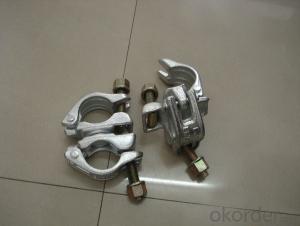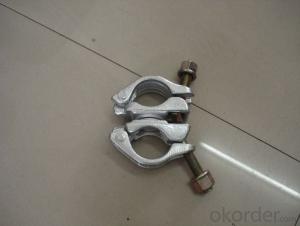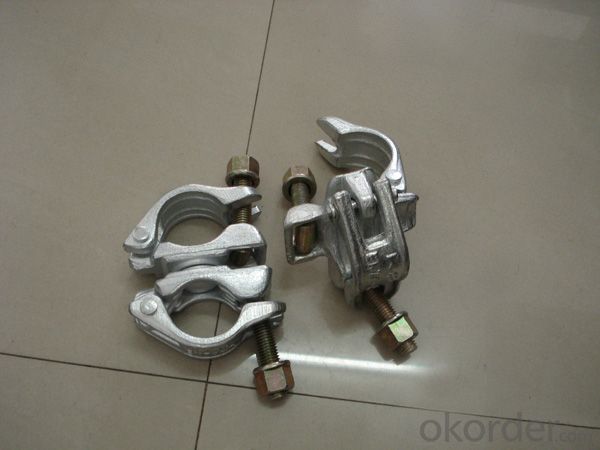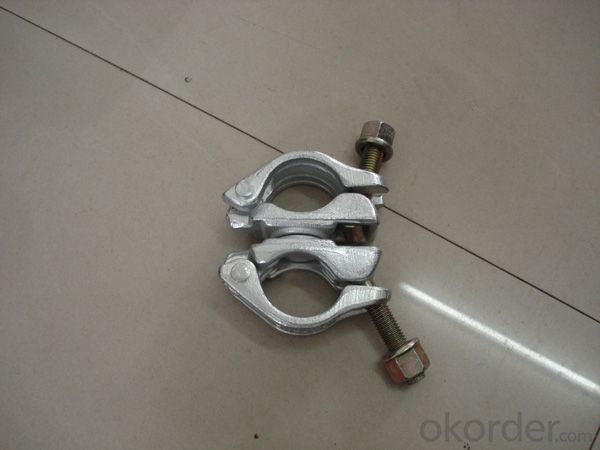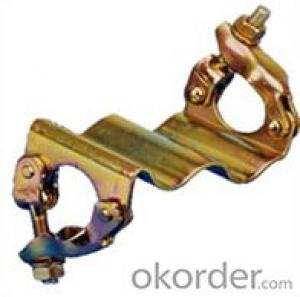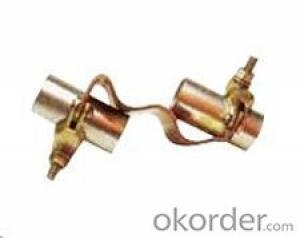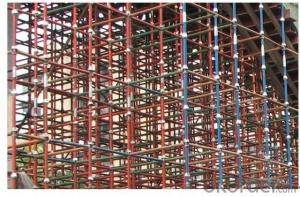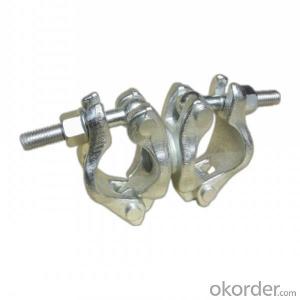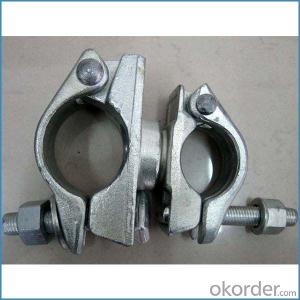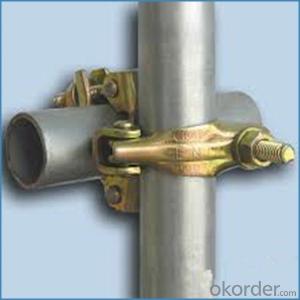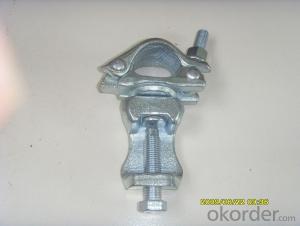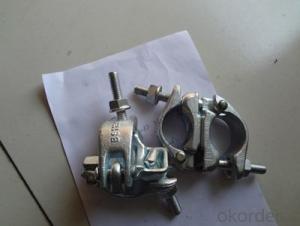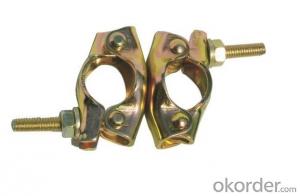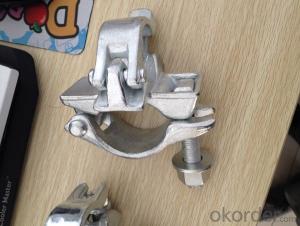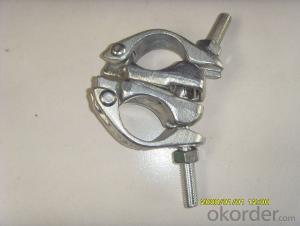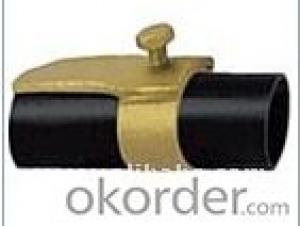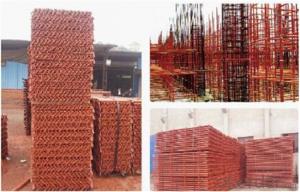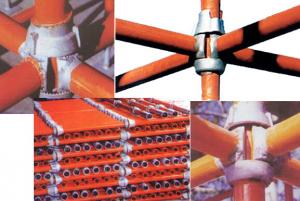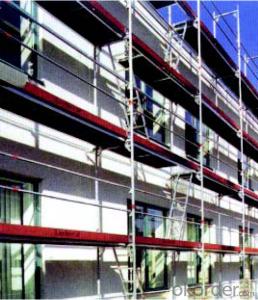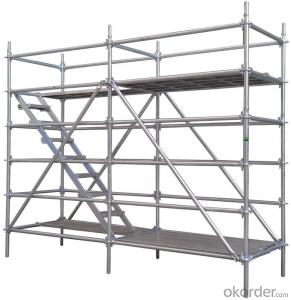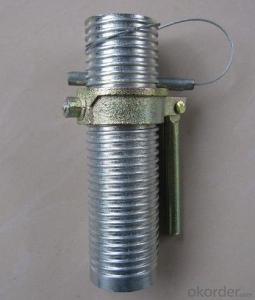scaffolding forged swivel coupler
- Loading Port:
- Nanjing
- Payment Terms:
- TT OR LC
- Min Order Qty:
- 1000 pc
- Supply Capability:
- 30000 pc/month
OKorder Service Pledge
OKorder Financial Service
You Might Also Like
German style drop forged swivel coupler
1.size:48.3mm
2.weight:1.3kg
3.Material: Q235/225/345
4.surface :self-color / zinc plate / electro galvanized / HDG or painted
5.Standard: EN74 ,BS1139
6.Anti-rust ,skidproof ,high breaking strength
7.Durable finish, reliability, low maintenance, corrosion resistance, robust construction and high tensile strength
8. OEM serice is available
SPECIFICATIONS:
1 MATERIAL:Q235
2 SWIVEL AND DOULE RIGHT ANGLE COUPLER
3 DROP FORGED AND PRESSED
4 BS1139 AND EN74 STANDARD
5 SIZE:48.3*48.3MM
6 PRESSED AND DROP FORED SWIVEL AND FIXED COUPLER/PUTLOG COUPLER/SLEEVE COUPLER/INNER CONNECTOR/BEAM COUPLER ETC.
Pressed swivel coupler 1.02kg galvanized/ hot dipped galvanized
- Q: What are the common industry best practices for using steel tube couplers in scaffolding?
- When it comes to using steel tube couplers in scaffolding, there are several industry best practices that are commonly followed. These practices ensure the safety and stability of the scaffolding structure. 1. Compatibility: It is crucial to ensure that the steel tube couplers being used are compatible with the scaffolding system. Couplers should be designed and manufactured specifically for scaffolding purposes and should meet relevant industry standards and regulations. 2. Inspection and Maintenance: Regular inspection of the couplers is essential to identify any signs of wear, damage, or deformation. Couplers should be checked for cracks, corrosion, or any other issues that may affect their integrity. Any damaged or faulty couplers should be immediately replaced. 3. Proper Installation: Couplers should be installed correctly, ensuring that they are securely attached to the tubes and tightened to the recommended torque. Over-tightening or under-tightening can lead to instability, so it is important to follow the manufacturer's guidelines for installation. 4. Load Capacity: The load capacity of the scaffolding structure should be carefully considered when selecting and using steel tube couplers. It is important to ensure that the couplers used are suitable for the intended load requirements. Overloading the scaffolding can compromise its stability and safety. 5. Interlocking Design: Steel tube couplers typically have an interlocking design that provides a secure connection between the tubes. Ensuring that the couplers are fully engaged and interlocked is crucial to maintaining the stability of the scaffolding structure. 6. Proper Alignment: When connecting tubes using couplers, it is important to ensure that the tubes are properly aligned and that there is no significant gap or misalignment between them. This helps maintain the integrity of the structure and prevents any potential movement or instability. 7. Regular Testing: Scaffolding structures that incorporate steel tube couplers should undergo regular load testing to ensure their stability and safety. This involves subjecting the scaffolding to loads that simulate real-world conditions to assess its performance and identify any potential weaknesses or issues. By following these industry best practices, scaffolding structures that incorporate steel tube couplers can be built and used in a safe and secure manner, providing a reliable support system for workers in various industries.
- Q: Are there any specific guidelines for the proper installation and tightening of steel tube couplers?
- Yes, there are specific guidelines for the proper installation and tightening of steel tube couplers. These guidelines usually include instructions on preparing the surface, aligning the couplers, ensuring a proper fit, and using the appropriate tools for tightening. It is important to follow these guidelines to ensure the integrity and safety of the connection.
- Q: How do steel tube couplers contribute to the overall stability of a scaffolding system?
- Steel tube couplers play a crucial role in enhancing the overall stability of a scaffolding system. These couplers are specifically designed to connect steel tubes together, ensuring a strong and secure framework. One of the key contributions of steel tube couplers is their ability to provide a rigid connection between the tubes, creating a solid structure. By securely fastening the tubes together, the couplers prevent any movement or rotation, thereby maintaining the stability of the scaffolding system. This is particularly vital in ensuring the safety of workers who rely on the scaffolding for support while undertaking various tasks at elevated heights. Additionally, steel tube couplers also enable the scaffolding system to withstand heavy loads and forces. The couplers distribute the weight evenly across the connected tubes, preventing any concentration of stress or strain on a single point. This distributed load capacity enhances the overall stability of the scaffolding system, ensuring its ability to withstand the demands of different construction and maintenance activities. Moreover, steel tube couplers contribute to the adaptability and versatility of scaffolding systems. With various types of couplers available, such as swivel, right-angle, and sleeve couplers, different configurations and angles can be achieved, allowing for the creation of complex scaffolding structures. This adaptability ensures that scaffolding systems can be customized to suit specific construction requirements, further enhancing their overall stability. In summary, steel tube couplers significantly contribute to the overall stability of a scaffolding system by providing a rigid connection between tubes, distributing loads evenly, and allowing for adaptability. These couplers play a vital role in ensuring the safety and reliability of scaffolding structures, making them an essential component of any construction or maintenance project.
- Q: Do steel tube couplers require any special maintenance or care?
- Yes, steel tube couplers do require some special maintenance and care to ensure their proper functioning and longevity. Regular inspections should be performed to check for any signs of wear, corrosion, or damage. If any issues are identified, immediate action should be taken to repair or replace the coupler. Additionally, it is crucial to keep the couplers clean and free from dirt, debris, or any other substances that can cause corrosion or hinder their performance. Regular cleaning with a mild detergent and water solution can help remove any buildup and maintain the couplers in good condition. Furthermore, the couplers should be stored in a dry and protected environment to prevent exposure to moisture or extreme temperatures, which can lead to rust or other forms of damage. It is advisable to keep the couplers covered or stored in a sealed container when not in use. Proper handling and usage are also essential to ensure the longevity of steel tube couplers. Avoid excessive force or rough handling during installation or removal, as this can cause damage to the couplers. It is recommended to follow the manufacturer's instructions and guidelines for the specific coupler model to ensure proper use and maintenance. In summary, steel tube couplers require regular inspections, cleaning, and proper storage to maintain their performance and durability. Following these maintenance practices will help extend the lifespan of the couplers and ensure their safe and efficient operation.
- Q: How do steel tube couplers contribute to the stability of a scaffolding structure?
- Steel tube couplers contribute to the stability of a scaffolding structure by providing a secure and reliable connection between the individual tubes. These couplers are designed to join the tubes together, ensuring that they remain aligned and in place during construction activities. This connection enhances the overall stability of the scaffolding system, preventing any movement or displacement that could compromise the safety of workers and the structure itself.
- Q: How do right-angle couplers work in scaffolding?
- Right-angle couplers are an essential component in scaffolding systems as they play a crucial role in connecting two perpendicular tubes together at a 90-degree angle. These couplers work by providing a secure and reliable connection between the tubes, ensuring stability and strength in the scaffolding structure. The working principle of right-angle couplers is relatively simple. They generally consist of two main parts: a body and a bolt. The body is designed with two open ends that fit perfectly around the tubes, while the bolt passes through the body, securing the two tubes together when tightened. To use a right-angle coupler, the two tubes are inserted into the open ends of the coupler body. Once the tubes are in place, the bolt is inserted through the body and tightened using an appropriate tool, such as a spanner or wrench. This action compresses the body of the coupler against the tubes, creating a firm and reliable connection. One crucial aspect of right-angle couplers is their ability to provide a strong grip on the tubes. This is achieved through the use of teeth or serrations on the inside surface of the coupler body. These teeth bite into the tubes when the bolt is tightened, enhancing the grip and preventing any slippage or movement. Another important function of right-angle couplers is their ability to resist shear forces. Shear forces occur when two perpendicular tubes try to slide against each other. Right-angle couplers are specifically designed to withstand these forces and maintain the stability of the scaffolding structure. In addition to their primary function of connecting tubes at right angles, right-angle couplers also allow flexibility in scaffolding design. They enable the construction of various configurations, such as T-joints or cross-bracing, enhancing the versatility and adaptability of the scaffolding system. Overall, right-angle couplers are crucial components in scaffolding systems, providing a secure and stable connection between perpendicular tubes. Their design and functionality ensure the safety and strength of the scaffolding structure, making them an indispensable part of the construction industry.
- Q: How do steel tube couplers ensure proper alignment and connection of scaffolding tubes with different diameters?
- The design and functionality of steel tube couplers guarantee the correct alignment and connection of scaffolding tubes with varying diameters. These couplers have been specifically designed to securely connect two scaffolding tubes of different sizes while ensuring alignment. An important characteristic of steel tube couplers is their adjustable design. Typically, these couplers possess a threaded bolt or collar mechanism that allows for size adjustment to match the diameters of the connected tubes. This adjustable feature ensures a secure fit onto both tubes, regardless of their differing diameters. Furthermore, steel tube couplers often come equipped with internal gripping teeth or ridges. These teeth or ridges are strategically placed inside the coupler to provide a strong grip on the tubes. When the coupler is tightened, these teeth or ridges dig into the surface of the tubes, creating a robust connection that prevents slippage and maintains alignment. Moreover, steel tube couplers are typically constructed using high-quality steel materials renowned for their strength and durability. This construction guarantees that the couplers can withstand the weight and load placed on the scaffolding without compromising the connection or alignment of the tubes. In conclusion, steel tube couplers ensure the proper alignment and connection of scaffolding tubes with varying diameters by utilizing an adjustable design, internal gripping teeth or ridges, and high-quality steel construction. These features work together to create a secure and reliable connection that maintains tube alignment and guarantees the stability and safety of the scaffolding structure.
- Q: Can steel tube couplers be used in scaffolding projects with heavy loads?
- Scaffolding projects with heavy loads can indeed incorporate steel tube couplers. These couplers are specifically engineered to establish a sturdy and reliable connection between scaffolding tubes, thereby ensuring stability and safety. They are frequently utilized in construction endeavors involving substantial loads, such as tall buildings or industrial facilities. Made from top-notch steel, these couplers are designed to endure the weight and pressure exerted by heavy loads. Nevertheless, it is imperative to guarantee accurate installation of the couplers and to ensure that the scaffolding structure is adequately designed and supported to accommodate the anticipated load. Consistently inspecting and maintaining the scaffolding system is also of utmost importance in order to uphold its structural integrity and safety.
- Q: Can steel tube couplers be used in confined spaces?
- Confined spaces can indeed accommodate steel tube couplers. These couplers, commonly employed in construction, serve the purpose of connecting and joining steel tubes together. Versatile and adaptable, they prove useful in various scenarios, including cramped construction sites, underground pipelines, and tunnels. Compact and lightweight, steel tube couplers excel in confined spaces with limited room. Their easy maneuverability and installation facilitate efficient construction within tight areas. Furthermore, their ability to bear heavy loads ensures the structural integrity and stability of connected tubes in such restricted environments. Adding to their appeal, steel tube couplers resist corrosion and boast remarkable durability, making them viable for long-term usage in challenging conditions. Their strength and dependability establish them as a reliable choice for confined spaces where safety and performance are paramount. In conclusion, steel tube couplers offer a suitable solution for confined spaces, thanks to their compact design, easy installation, high load-bearing capacity, and durability. However, it remains crucial to consider the specific requirements and regulations of the particular confined space and ensure compliance with safety standards before employing steel tube couplers.
- Q: Can steel tube couplers be used in scaffolding projects with limited foundation support?
- Steel tube couplers are suitable for scaffolding projects with limited foundation support. They are extensively used in scaffolding systems to link steel tubes, creating a robust and secure structure. These couplers are designed to withstand heavy loads and are commonly employed in construction projects where safety is of utmost importance. In projects with limited foundation support, steel tube couplers offer numerous advantages. They enable versatile and flexible scaffolding designs as they can be easily adjusted and repositioned to accommodate various ground conditions. This flexibility aids in distributing the load across multiple support points, thereby minimizing the impact on the limited foundation support available. Moreover, steel tube couplers are renowned for their durability and strength. They establish a stable and secure connection among scaffolding components, ensuring the safety of workers and materials. This aspect is particularly vital in projects with limited foundation support as a reliable and sturdy scaffolding structure is crucial. Nevertheless, it is always advisable to seek advice from a structural engineer or scaffolding expert before using steel tube couplers in projects with limited foundation support. They can evaluate the specific site conditions and offer guidance on the appropriate design and utilization of scaffolding systems to ensure compliance with local regulations and guarantee safety.
Send your message to us
scaffolding forged swivel coupler
- Loading Port:
- Nanjing
- Payment Terms:
- TT OR LC
- Min Order Qty:
- 1000 pc
- Supply Capability:
- 30000 pc/month
OKorder Service Pledge
OKorder Financial Service
Similar products
Hot products
Hot Searches
